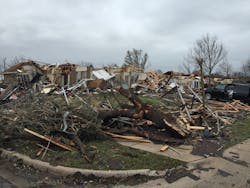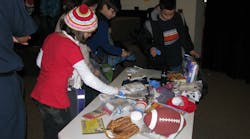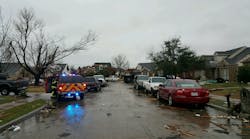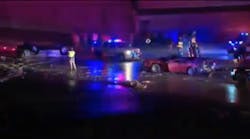“We really saw the best of the community that night. It wasn’t just firefighters helping out, it was neighbors rescuing neighbors,” Battalion Chief Scott Roseberry said of the actions he witnessed on Dec. 26 after Garland was hit by an EF4 tornado.
Garland’s first responders had already been taxed twice as two major flooding events caused widespread damage. And in May, two men were shot by police after an alleged ISIS terror attack at the Curtis Culwell Center.
“We’ve had a lot of practice this year with the three major incidents and we knew we had a lot of incident command experience, but this was just overwhelming.”
Garland has 60 firefighters on-duty at 11 fire stations operating with six engines, five quints (trucks), 11 ambulances and two battalion chiefs who divide the city north and south.
When reports of severe weather were coming in, Battalion 2 Chief Scott Roseberry reached out to Battalion 1. Based on a two majors flooding events in the city earlier in 2015, the two decided that Battalion 1 would work with the 911 center to prioritize calls and deploy the appropriate assignments while Battalion 2 would remain in the field.
“We had just finished dinner and we were going to play cornhole to see who was going to the dishes when the sirens went off,” Roseberry recalled of the moments before EF4 tornado hit his city.
As he monitored the fire department radio, he immediately heard urgent radio traffic.
Truck 5 Captain Jon Tomlinson, the southernmost company in the city, reported that there was a tornado on the ground just south of the station. The funnel was moving northeast and the crew jumped aboard the apparatus to stay safe.
The next radio traffic came from Ambulance 5, who was with an engine company on a medical call at a Walmart store. They confirmed that the tornado was on the ground. They retreated with their patient into the building for safety.
911 Calls Start Coming In
At 6:53 p.m., Garland fire crews were dispatched to Crestpoint Lane for a caller who reported that her home collapsed and she was trapped inside with 10 people.
Upon hearing the radio traffic, Roseberry called companies to get the location of the tornado. “My concern was not sending unit into the middle of the tornado.”
A crew confirmed that the tornado has moved out of the city and across Lake Ray Hubbard toward Rowlett.
“Before we knew it, we had five calls working on five tactical channels and it was becoming overwhelming quickly.”
Battalion 1 began coordinating emergency calls while Roseberry responded to the area where three collapsed homes were reported.
“I stopped once I saw houses with damage...I didn’t want to get too close to the major damage to setup command,” he called.
Upon reaching the area with the heaviest damage, Capt. Tomlinson radioed “We’ve got damage everywhere. There’s houses torn up everywhere.”
Just three minutes after the first call was dispatched, Roseberry ordered that the city’s emergency operations center be activated.
Just after 7 p.m., Garland crews were dispatched to I-30 where more two dozen vehicles had been picked up by the fierce winds and thrown about. He would later learn that eight people died in that horrific scene along the interstate.
They were also dispatched to the Landmark at Lake Village West Apartments along Interstate 30 where numerous reports of collapsed buildings and people trapped started to pour in from.
Several multi-story building suffered extensive damage and firefighters placed ladders to balconies to help upper floor residents escape.
“My first thought was the safety of responders. Second, we needed to get a scope of this thing and get units in the area,” Roseberry said. “I can’t do that until we get boots on ground. We got overwhelmed very quickly…once resources showed up, it was trying to decide who needs resources and what they need.”
He established five operational commands in the areas: at the accident scene on Interstate 30, at the Landmark apartments and three in residential neighborhoods that suffered the most damage.
“Each of those guys thought their area was the worst,” Roseberry said of the reports he was receiving from command officers in the field. “It wasn’t until morning when they drove around and saw how bad it was that they realized it wasn’t always the case.”
He related the story of Ambulance 4’s crew hearing a scream for help from a collapsed structure. As they got closer, the noise got louder and the crew was able to rescue an elderly woman from a void in the wreckage.
From the reports they collected, they assisted with the rescue of 100 from debris and 15 were transported to the hospital.
Command Established, Resources Requested
Some of the first outside help was received by a number of Dallas police officers who responded when they saw the tornado on the ground. They were assigned to work with Truck 5 in one of the hardest hit neighborhoods.
While mutual aid was requested almost immediately, some of their traditional mutual aid partners had already by summoned by neighboring city Rowlett, where over 1,100 structures had been damaged.
By 7:30, Roseberry moved his command post a Walmart parking lot and that allowed them plenty of space to staging incoming resources. First responders staffing closed to 50 units from 15 entities responded to assist Garland Saturday night, including a fire department from 30 miles away and several private ambulance services. The Arlington Fire Department technical rescue team responded about 40 miles to assist with any heavy extrications or in-depth searches.
He noted that guards were added to the command post to prevent interruptions from people or groups who were offering help.
He assigned police officers to find the the perimeters of the damage and from there they used the regional Mapsco books to establish search grids.
Scaling Back
By 4 a.m., Roseberry said “we felt confident that we had done a good secondary search. It rained the whole time and it was really starting to get cold. It wasn’t safe for in-depth searches.”
At that point they started to release mutual aid resources and send off-duty firefighters to fire stations to rest before their regular shifts started in the morning.
The next operational period began at 7 a.m. and crews, along with the Arlington technical rescue team, conducted in-depth searches.
Off-duty Firefighters and Outside Support
About 70 off-duty firefighters returned to Garland to assist and they were utilized to staff mutual aid apparatus, work at the different scenes and backfill the vacated fire station.
One off-duty crew staffing an engine responded to a cardiac arrest in downtown Garland and they were able to revive the victim with CPR.
The support that responders and residents received was overwhelming.
Roseberry said that Walmart workers brought shopping carts full of water, food and drinks to responders in the staging area. When he asked if they had paint for crews to begin marking buildings, they returned with a shopping cart full of spray paint.
Nearby restaurants prepared meals and brought them to the staging area to nourish firefighters during the first few days.
“I was amazed at those who were off-duty and dropped everything in the middle of the storm and who wanted to come help the residents of Garland. And the on-duty crews who kept going on despite the conditions.”
Lessons Learned
The department is still reviewing the incident, but Roseberry shared a few things they’ve learned.
- All incoming 911 calls were given to a battalion chief who then assigned the proper units.
- Communications were quickly overwhelmed. Within minutes, they had five major incidents operating on five tactical channels. It soon expanded to 10 operational channels. He said there was no means to effectively monitor each channel.
- Due to the overwhelming number of firefighters required in the field, the initial command staff was small and became a challenge to track all of the resources.
- The staging area and command post relocated away from the destruction were key, but there needs to be on-site separation for both and a staging officer is critical to track resources.
- Despite training exercise and three major incidents in the city in 2015, Level 2 staging was a new task. “That’s not something you can learn on any tabletop exercise,” he said.
- The radio was full of traffic and Roseberry said many communications were handled by cell phones. With mutual aid coming from so far away, some resources didn’t have the proper radios to communicate with each other and Garland firefighters were assigned to ride with them.
- A number of contractors and people arrived to help and they were corralled into one area. Not knowing their certifications or true intentions opens the door to problems.
All told, the city inspected 1,120 homes damaged by the tornado and found that 216 would not be inhabitable.
Eight people died at the crash on I-30 and a ninth person succumbed to injuries on Jan. 9.









